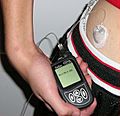Hypoglycemia facts for kids
Hypoglycemia is a medical emergency that involves lower than normal blood sugar. Normal blood sugar is about 70 to 100mg per deciliter. All of the cells in the body need sugar to do their jobs and to survive. When a person does not have enough blood sugar, their body cannot work normally.
Hypoglycemia can cause many symptoms. Some common symptoms are nausea, feeling hungry, sweating, feeling sad, and heart palpitations (feeling the heart pounding). Bad hypoglycemia can make a person act like they are drunk or have taken drugs. Very bad hypoglycemia can look exactly like a stroke.
Hypoglycemia can happen to anyone, at any age, but it usually happens in people who are diabetic. It is often a complication of treatment for diabetes with insulin or oral medications.
Hypoglycemia is treated by returning the blood sugar levels back to normal. Often, a hypoglycemic person can bring their blood sugar levels back up by eating. In the worst cases, when the blood sugar is very low, hypoglycemia is treated by giving sugar water intravenously (through a needle placed into a vein).
The brain and other parts of the body cannot work without sugar. Because of this, severe (very bad) hypoglycemia can cause serious medical problems (like seizures) or even death if it is not treated quickly enough.
Images for kids
See also
 In Spanish: Hipoglucemia para niños
In Spanish: Hipoglucemia para niños



